Unpacking and publishing the Phaistos Disk since 1993
HOME | PREVIOUS | NEXT | SITEMAP
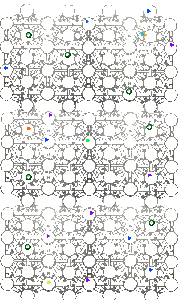 |
The fascinating story of alien participation in Earth history--who they were, where they come from, how they get here, what they do here and why they come here--may be historically preserved by two artifacts and an enduring legend, namely the Phaistos Disk (1600 BCE), the Maze of Daedalus mosaic (4th c. CE) and the Maze of Daedalus legend (1600 BCE). The Phaistos Disk is a round maze. The Maze of Daedalus mosaic (left) is a square maze. 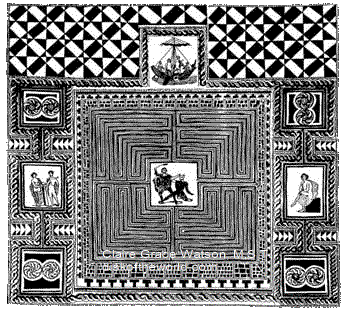 The universe is a vast intellect comprised of innumerable individual intellects. This is the archetype for existence, at all levels. Alien intelligence, particularly the Sirians from the Sirius system and the Ejoesa from system Apollonius, a quasar (range 8 to 9 megahertz), may have participated in the development of early Earth civilizations. They may still be actively involved in our development. Evidence exists that indicates the planet Earth was colonized by beings from other worlds. Within the pages of this book is additional evidence in support of these assertions.
The universe is a vast intellect comprised of innumerable individual intellects. This is the archetype for existence, at all levels. Alien intelligence, particularly the Sirians from the Sirius system and the Ejoesa from system Apollonius, a quasar (range 8 to 9 megahertz), may have participated in the development of early Earth civilizations. They may still be actively involved in our development. Evidence exists that indicates the planet Earth was colonized by beings from other worlds. Within the pages of this book is additional evidence in support of these assertions.
Now about these mazes, the Maze of Daedalus marble and limestone tile mosaic, 15 ft. wide and 18 ft. long, was discovered in 1815 on the floor of a barn in Austria. It probably was completed in the 4th c. CE, long before Arabic numerals were used extensively in place of Roman numerals. This is mentioned because there are six number 4's camouflaged in the mosaic. As for the history of maze mosaics, the leading artists of the Greco-Roman world developed mosaics in ancient Greece. The art form evolved in ancient Crete where the people gathered pebbles from the beach and set them in a cement bed to provided durable flooring in homes.
The Maze of Daedalus mosaic demonstrates the artistic device of "continuous representation," which is the depiction of successive incidents or scenes within a single composition. Continuous representation is a narrative device first used in ancient Mesopotamia by artists telling a story with their art. This maze mosaic artist uses continuous representation to tell a story that portrays the 4th dimension of time, a dimension in which an objective "now" does not exist. This is an interesting way to portray the 4th dimension, by using a two-dimensional image, and it shows a great intellect at work in the creation of this masterpiece, Maze of Daedalus. It also proves the Maze of Daedalus legend was known in the 4th century, even though the Cretan civilization itself was not known to exist outside of legend until excavated by Sir Arthur Evans in the early 20th century. We will look closer at this square maze, but first the round maze of the Phaistos Disk.
The Phaistos Disk (below bottom) is a terra-cotta disk ceremically fired and hardened for preservation unlike the thousands of artifacts that were baked. The disk is a perfect picture of the universal and astrophysical vortex-portal with the elements of creation stirring round and round. It is only 6-1/4" in diameter and 1" thick. It was found in 1908 at Phaistos, Crete, beside a tablet of Linear A writing of ancient Crete.
The Phaistos Disk is esteemed by archaeologists as something special and is 2 spirals inscribed with unique signs or pictographs in a unique style of continuous representation.
The signs were impressed with 47 different stamps, 37 of which were repeated. This is the earliest printing press technology known in the Western world. (This was the accepted explanation when I wrote this book, and it still is. However, I have proven this theory to be incorrect. See my recent discovery of how these pictographs were impressed onto the disk here.)
On Side 1 of the disk (above top), 121 impressions were made with 35 different stamps and on Side 2 (above), 119 impressions were made, again with 35 different stamps. Archaeologists believe the pictographs represent a language. It is a symbol language.
(I researched this, and went and saw the disk in Heraklion. The disk was not made with stamps, even though the pictographs appear to be raised in photographs. They are, in fact, carved into the clay.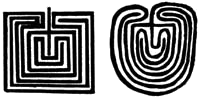 Two such Hopi Indian mazes, round and square, (left) are said to symbolize the human body and the axis of the world. This instructs about the relationship of microcosm to macrocosm. As a point of interest, the axis of the universe, according to ancient beliefs, is the Pleiades in Taurus. The implication is that our bodies are somehow intimately connected to a point far away in space, in the Taurus constellation. As this book will attempt to show, both mazes symbolize the vortex-portal, a geophysical and metaphysical phenomenon that exists as part of our reality and that gives us access to that distant point in space, to a place in Taurus, for example, to which we are apparently intimately tied.
Two such Hopi Indian mazes, round and square, (left) are said to symbolize the human body and the axis of the world. This instructs about the relationship of microcosm to macrocosm. As a point of interest, the axis of the universe, according to ancient beliefs, is the Pleiades in Taurus. The implication is that our bodies are somehow intimately connected to a point far away in space, in the Taurus constellation. As this book will attempt to show, both mazes symbolize the vortex-portal, a geophysical and metaphysical phenomenon that exists as part of our reality and that gives us access to that distant point in space, to a place in Taurus, for example, to which we are apparently intimately tied.

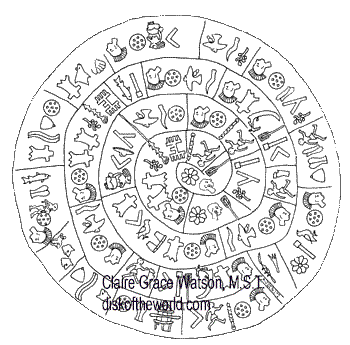
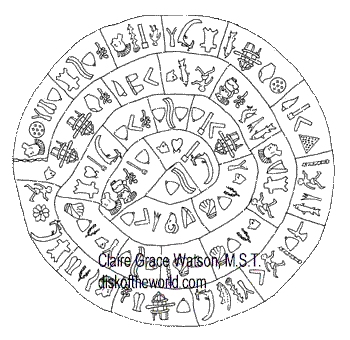
 
|
The origin of the disk and the setting for the maze mosaic is Bronze Age Crete during the fabulous Minoan civilization that some scholars say gave rise to the legend of Atlantis. This particular Atlantis theory meets with resistance from ET enthusiasts, who insist that an advanced civilization really did once exist on this planet. Was that civilization Bronze Age Crete?
From our perspective the Minoan civilization seems unbelievably advanced for its time (1600 BCE). The people lived comfortably in adobe townhouses that had rooftop patios (above). They enjoyed plumbing and bathtubs and flushing toilets. The Cretans invented paved roads and paved them with shell and rock. The gay frescos in the palaces portray the people as wealthy, carefree, sophisticated and uninhibited. Their luxuriant lifestyle was a sudden advance from the primitive one immediately preceding it, and archaeologists cannot find an explanation for the overnight change in this civilization from mud huts and nearly nonexistent Bronze Age technology to architecturally designed palaces, complete with 20th century conveniences.
Some of these things can be explained by the fact that the Cretans, unlike the Sumerians and the Egyptians, spent their wealth on themselves rather than on temples and religious monuments. No doubt they gave great consideration to their own comfort and entertainment--hence the palaces and the extravagant spectacle involved in the bull sports. But archaeologists and historians, lacking religious artifacts from this period, underestimate the intelligence of this civilization by speculating that the Cretans were an earth goddess society. The religion of the Cretans was aniconic because, as the Phaistos Disk will show when we study it closely, the Cretans themselves were the embodiment of their spiritual beliefs in their manner of dress, in their lifestyle and in their artistic expression. Each Cretan lady was an Isis Unveiled; each gentleman was an Osiris. But first, let us take a close-up look at the Minoan civilization.
Atlantis also has been described using the same words. It was supposed to have had a powerful and magnificent island state with many ports, an unchallenged naval fleet, beautiful palaces, superb architects, excellent hydraulic engineers, and people who loved bull sports. Alas, Atlantis was destroyed in one day and night by the volcano, the earthquakes and the floods. So it was that the beautiful people--the Cretans-Atlanteans--vanished.
The maze mosaic can be said to be a record of lost Earth history--a history that begins to be revealed as the mosaic tells of the legend of the Maze of Daedalus and its three stars: Theseus, Ariadne, and the Minotaur. But notice if you will that in the background of the maze, and straining to emerge, is the possible portrayal of the moment the Sirians arrived at Cheops from the star Sirius in Canis Major. Then, as the maze puzzle is resolved, the mystery of its connection to Cheops becomes the new puzzle, resolved in turn by the Phaistos Disk. But, first things first. 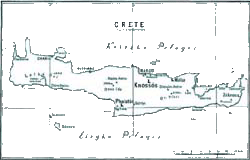 The isle of Crete during the Bronze Age had many active ports, a powerful and unchallenged navy, beautiful palaces, superb architects, excellent hydraulic engineers, and people who loved bull sports. But this modern prosperity was no defense against the volcano, the earthquakes and the tidal wave that destroyed the civilization in just one day and night.
The isle of Crete during the Bronze Age had many active ports, a powerful and unchallenged navy, beautiful palaces, superb architects, excellent hydraulic engineers, and people who loved bull sports. But this modern prosperity was no defense against the volcano, the earthquakes and the tidal wave that destroyed the civilization in just one day and night.
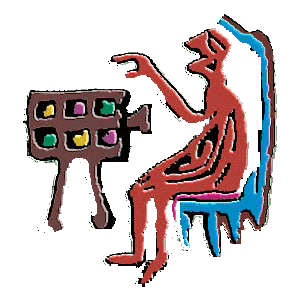 The destruction of Crete erased nearly all evidence of its flourishing civilization that was not known to exist outside myth and legend until the 20th century when its discovery shocked the world. Even so, a tile artist in the 4th c. CE, who could have known nothing of the palace at Knossos, provided specific details of its ground plan in the Maze of Daedalus mosaic. To gain the revelation of interstellar flight portals and to see how they are connected with this maze mosaic, we must dive into the story of the Minotaur, a monster apparently, a horned being who ate humans. When we do, we will discover that the maze mosaic works on multiple levels, all of them interconnected. At another level, and camouflaged on the maze mosaic, is the incredible depiction of the remarkable events that occurred in Egypt at the Great Pyramid of Cheops sometime before 1600 BCE. That revelation is another "thread of Ariadne," which we will follow later on. But first, a close look at the Maze of Daedalus mosaic.
The destruction of Crete erased nearly all evidence of its flourishing civilization that was not known to exist outside myth and legend until the 20th century when its discovery shocked the world. Even so, a tile artist in the 4th c. CE, who could have known nothing of the palace at Knossos, provided specific details of its ground plan in the Maze of Daedalus mosaic. To gain the revelation of interstellar flight portals and to see how they are connected with this maze mosaic, we must dive into the story of the Minotaur, a monster apparently, a horned being who ate humans. When we do, we will discover that the maze mosaic works on multiple levels, all of them interconnected. At another level, and camouflaged on the maze mosaic, is the incredible depiction of the remarkable events that occurred in Egypt at the Great Pyramid of Cheops sometime before 1600 BCE. That revelation is another "thread of Ariadne," which we will follow later on. But first, a close look at the Maze of Daedalus mosaic.
color=#201509Out in the deep dark sea there lies a land called Crete, a rich and lovely land, washed by the sea on every side and boasting ninety cities. One of these cities is called Knossos, and there King Minos ruled and enjoyed the friendship of almighty Zeus.
The Minotaur was housed beneath the labyrinthine palace at Knossos. The palace contained so many twisting passages, staircases and subterranean rooms that it is believed to be the legendary Maze of Daedalus. (Illus. 3)
 Portrayed in the tile mosaic is the famous Maze of Daedalus legend of ancient Crete, passed down through time in the guise of a remarkable story, as told to us by the mysterious Greek poet, Homer.
Portrayed in the tile mosaic is the famous Maze of Daedalus legend of ancient Crete, passed down through time in the guise of a remarkable story, as told to us by the mysterious Greek poet, Homer.
 Poseidon, god of the sea and special god of Plato's Atlantis, presented King Minos with a white bull. Queen Pasiphae (above, Illus. 1), the king's wife, lusted after the bull! Pasiphae asked Daedalus, the palace architect, to design a bed for the mating to take place! Daedalus complied and the result of the mating was the Minotaur, half-bull, half-human. (left, Illus. 2)
Poseidon, god of the sea and special god of Plato's Atlantis, presented King Minos with a white bull. Queen Pasiphae (above, Illus. 1), the king's wife, lusted after the bull! Pasiphae asked Daedalus, the palace architect, to design a bed for the mating to take place! Daedalus complied and the result of the mating was the Minotaur, half-bull, half-human. (left, Illus. 2)
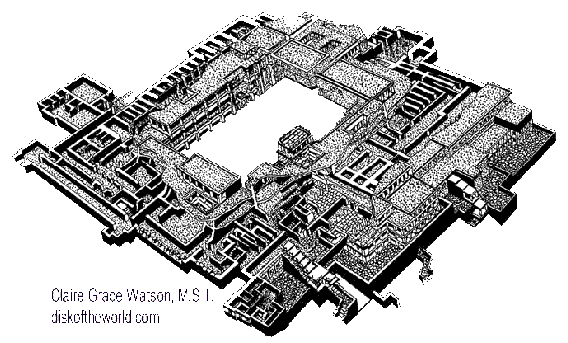
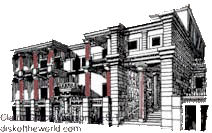
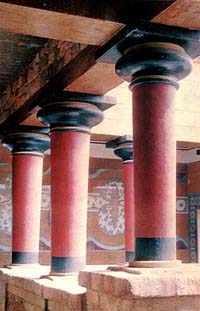 The palace was designed around the continuous activities of the Central Court, with the western facade as the focus (above). Central Court displays the Cretan designed upside-down Doric columns (above and left) and two of the famous Figure 8 shields of ancient Crete (left).
The palace was as big as Buckingham Palace, containing 700 rooms and covering 6-1/2 acres. At the beautiful palace, with the city of Knossos in the background, was an entrance via a stone viaduct at the SW corner of the palace.
The palace was designed around the continuous activities of the Central Court, with the western facade as the focus (above). Central Court displays the Cretan designed upside-down Doric columns (above and left) and two of the famous Figure 8 shields of ancient Crete (left).
The palace was as big as Buckingham Palace, containing 700 rooms and covering 6-1/2 acres. At the beautiful palace, with the city of Knossos in the background, was an entrance via a stone viaduct at the SW corner of the palace.
The Minotaur was fed young Greeks, war tribute paid to King Minos by the king of Greece. The Greeks were put in the maze, where they wandered hopelessly lost until the Minotaur found them and ate them. This part of the legend, the eating of humans, is dramatically illustrated by the rock drawing (above) found in a cave in Auanrhet, Tassili in Africa, in which this Minotaur takes a bite out of the leg of a frightened young woman. This Minotaur is equipped with some kind of body pods or antennae. This legend of a horned being who eats humans is resurfacing again in the 90's, in modern ET lore. Perhaps there is some truth in it. Here is another cave drawing (right) that seems to indicate its possibilities.
Daedalus advised Ariadne to take a ball of thread, now known as Ariadne's Thread of Love, to unwind inside the maze for Theseus to follow back out. Ariadne and Theseus are seen preparing to enter the maze from the top square of the Maze of Daedalus mosaic (top of maze), that is an exact drawing of the 4th c. CE tile mosaic.
At this point we must move to the next dimension of meaning in order to understand the significance of the maze and to arrive at its solution. The great and mysterious alchemist Fulcanelli will now take us to that level. "The picture of the labyrinth is thus offered to us as emblematic of the whole labour of the Great Work, with its two major difficulties, one the path which must be taken in order to reach the center-where the bitter combat of the two natures takes place-the other the way the artist must follow in order to emerge. It is there that the thread of Ariadne becomes necessary for him, if he is not to wander among the winding paths of the task, unable to extricate himself." (1)
When an alchemist refers to the Great Work, the reference pertains to something profound and includes the concept of space-time and energy-matter as being a curtain hanging between us and the nonspatial world. The Great Work has to do with lifting the curtain or with gaining access to the nonspatial realm of existence. One of the concepts involved here has to do with where the curtain lifts, and it also involves the esoteric spiritual legacy left us by the Sirians.
When the curtain lifts, it goes up in both subjective-nonordinary reality--so that knowledge is acquired in a mystical way--and it goes up in objective-ordinary reality, so that distance in objective, interstellar space is negated. The relationship of one to the other is All. When the curtain lifts, a portal is created and a privileged position vis-a-vis the universe is attained. From this position can be assessed the unseen, unknown realities. Some of these realities are unperceived by us because, says the alchemist Walter Lang, "Only a minute cross section of the total cosmic spectrum is bent by the senses and so rendered tangible." (2)
The entrance into the inner cosmos of subjective-nonordinary reality and into other planes of existence that we do not ordinarily perceive is via a spiraling path or Shamanic tunnel. Have you seen it? Its geophysical counterpart is the vortex. The meaning of the maze, whether square like the maze mosaic or round like the Phaistos Disk maze, is 'vortex-portal'.
The alchemists also called the Maze of Daedalus "Absolum." Walter Lang reminds us: "We would point out that this term (Absolum) is close to the Absolute, which is the name by which the ancient alchemists designated the philosophers' stone." (3) So we begin to see we find something profound in the Maze of Daedalus and the Phaistos Disk.
 Beneath the palace where the Minotaur lived in the depths of the labyrinth, excavators discovered water channels and conduits for heavy rainfall and huge drains large enough to stand in and walk upright. The palace was supplied with running water and flushing toilets, the result of the work of the brilliant hydraulic engineers who built this elaborate plumbing system, unique in the Bronze Age. The Minotaur roamed this subterranean, labyrinthine plumbing and drainage system beneath the palace.
Beneath the palace where the Minotaur lived in the depths of the labyrinth, excavators discovered water channels and conduits for heavy rainfall and huge drains large enough to stand in and walk upright. The palace was supplied with running water and flushing toilets, the result of the work of the brilliant hydraulic engineers who built this elaborate plumbing system, unique in the Bronze Age. The Minotaur roamed this subterranean, labyrinthine plumbing and drainage system beneath the palace.
 One of the Greeks the Minotaur was set to eat was Theseus, the son of the king of Greece, who sailed to Crete as a member of a sacrificial group but who planned to eliminate the Minotaur. Theseus, both then and now the greatest hero of Greece, enlisted the help of Ariadne, King Minos' daughter and the Minotaur's stepsister, to lead him into the maze. She in turn consulted Daedalus, that mysterious Cretan-Atlantean so active behind these scenes.
One of the Greeks the Minotaur was set to eat was Theseus, the son of the king of Greece, who sailed to Crete as a member of a sacrificial group but who planned to eliminate the Minotaur. Theseus, both then and now the greatest hero of Greece, enlisted the help of Ariadne, King Minos' daughter and the Minotaur's stepsister, to lead him into the maze. She in turn consulted Daedalus, that mysterious Cretan-Atlantean so active behind these scenes.
Then, Theseus is in the center of the maze where he is battling the Minotaur. (above top) As the battle ensues, Ariadne waits in no distress on the right. (above) Finally, Theseus and Ariadne are seen on the left turning a wheel. (below)
For comparative purposes and for mapping, we use the World Soul glyph (next, Illus. 4, see Forms and Archetypes of the World Soul.) This glyph is a complex and completed version of the Kabala Tree of Life.
Page 1 - Alien Participation | Amazement | Minoan Civilization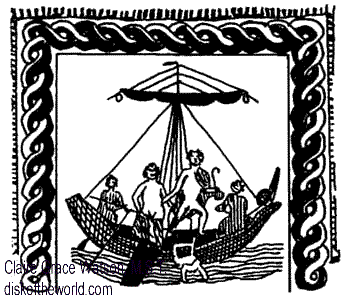 Even so, the maze mosaic seems to have been designed as a puzzle to be solved. The Maze of Daedalus tile mosaic is a graphic maze puzzle, defined as "the solution of which is an uninterrupted path through an intricate pattern of line segments from a starting point to a goal." This fits our maze puzzle perfectly. Close examination of this maze mosaic reveals a maze puzzle with no obvious uninterrupted paths from a starting point to a goal. Here we go. On the mosaic, Theseus and Ariadne are seen disembarking from a boat in the top square. (above)
Even so, the maze mosaic seems to have been designed as a puzzle to be solved. The Maze of Daedalus tile mosaic is a graphic maze puzzle, defined as "the solution of which is an uninterrupted path through an intricate pattern of line segments from a starting point to a goal." This fits our maze puzzle perfectly. Close examination of this maze mosaic reveals a maze puzzle with no obvious uninterrupted paths from a starting point to a goal. Here we go. On the mosaic, Theseus and Ariadne are seen disembarking from a boat in the top square. (above)
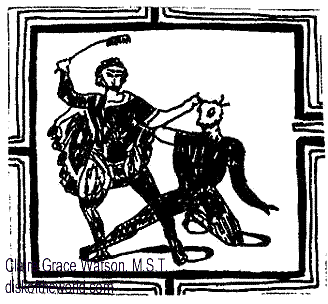
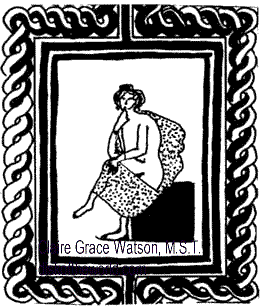
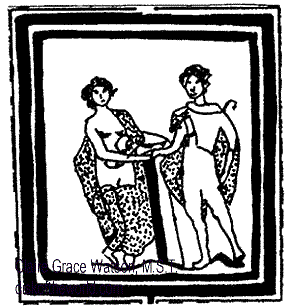
Deep Dark Sea | Central Court | The Minotaur
Theseus and Ariadne
Page 2 - Space-Time Continuum | The Shields
Page 3 - Universe Mindless?
Page 4 - Numerical Reality
Page 5 - The Field Fabric
Page 6 - The Pious Country
Page 7 - Spiritual Legacy from the Stars